Uniaxial Reloading Damage Characteristics of Critically Damaged Coal Samples at Different Confining Pressure Unloading Spans
Abstract
:1. Introduction
2. Coal Sample Preparation and Experiments
2.1. Coal Sample Preparation
2.2. Determination of Initial Damage to Coal Samples
2.3. Triaxial Compressive Strength Determination
2.4. Preparation of Damaged Coal Samples
3. Critical Damage Coal Sample Determination
4. Uniaxial Loading of Critically Damaged Coal Samples
4.1. Uniaxial Reloading Experiments on Critically Damaged Coal Samples
4.2. Stress Analysis of Critically Damaged Coal Samples
4.3. Acoustic Emission Signal Analysis
4.4. Fractal Characteristics
5. The Law of Energy Evolution
6. Conclusions
Author Contributions
Funding
Institutional Review Board Statement
Informed Consent Statement
Data Availability Statement
Conflicts of Interest
References
- Huang, D.; Li, Y. Conversion of strain energy in Triaxial Unloading Tests on Marble. Int. J. Rock Mech. Min. Sci. 2014, 66, 160–168. [Google Scholar] [CrossRef]
- D’amato, M.; Braga, F.; Gigliotti, R.; Kunnath, S.; Laterza, M. A numerical general-purpose confinement model for non-linear analysis of R/C members. Comput. Struct. 2012, 102, 64–75. [Google Scholar] [CrossRef]
- Baduge, S.K.; Mendis, P.; Ngo, T. Stress-strain relationship for very-high strength concrete (>100 MPa) confined by lateral reinforcement. Eng. Struct. 2018, 177, 795–808. [Google Scholar] [CrossRef]
- Dai, B.; Zhao, G.; Konietzky, H.; Wasantha, P.L.P. Experimental and Numerical Study on the Damage Evolution Behaviour of Granitic Rock during Loading and Unloading. KSCE J. Civ. Eng. 2018, 22, 3278–3291. [Google Scholar] [CrossRef]
- Qiu, S.-L.; Feng, X.-T.; Xiao, J.-Q.; Zhang, C.-Q. An Experimental Study on the Pre-Peak Unloading Damage Evolution of Marble. Rock Mech. Rock Eng. 2013, 47, 401–419. [Google Scholar] [CrossRef]
- Huang, X.; Liu, Q.; Liu, B.; Liu, X.; Pan, Y.; Liu, J. Experimental Study on the Dilatancy and Fracturing Behavior of Soft Rock Under Unloading Conditions. Int. J. Civ. Eng. 2017, 15, 921–948. [Google Scholar] [CrossRef]
- Li, G.; Wang, Y.; Wang, D.; Yang, X.; Wang, L.; Li, Y.; Zhang, S. Creep damage model of rock with varying-parameter under the step loading and unloading conditions. Sci. Rep. 2021, 11, 24057. [Google Scholar] [CrossRef] [PubMed]
- Hong, L.; Zhou, Z.-L.; Yin, T.-B.; Liao, G.-Y.; Ye, Z.-Y. Energy consumption in rock fragmentation at intermediate strain rate. J. Central South Univ. Technol. 2009, 16, 677–682. [Google Scholar] [CrossRef]
- Friedrich, L.F.; Tanzi, B.N.R.; Colpo, A.B.; Sobczyk, M.; Lacidogna, G.; Niccolini, G.; Iturrioz, I. Analysis of Acoustic Emission Activity during Progressive Failure in Heterogeneous Materials: Experimental and Numerical Investigation. Appl. Sci. 2022, 12, 3918. [Google Scholar] [CrossRef]
- Rodríguez, P.; Celestino, T.B. Application of acoustic emission monitoring and signal analysis to the qualitative and quantitative characterization of the fracturing process in rocks. Eng. Fract. Mech. 2019, 210, 54–69. [Google Scholar] [CrossRef]
- Liu, X.; Liu, Z.; Li, X.; Gong, F.; Du, K. Experimental study on the effect of strain rate on rock acoustic emission characteristics. Int. J. Rock Mech. Min. Sci. 2020, 133, 104420. [Google Scholar] [CrossRef]
- Moradian, Z.; Einstein, H.H.; Ballivy, G. Detection of Cracking Levels in Brittle Rocks by Parametric Analysis of the Acoustic Emission Signals. Rock Mech. Rock Eng. 2016, 49, 785–800. [Google Scholar] [CrossRef]
- Meng, Q.; Zhang, M.; Han, L.; Pu, H.; Nie, T. Effects of Acoustic Emission and Energy Evolution of Rock Specimens Under the Uniaxial Cyclic Loading and Unloading Compression. Rock Mech. Rock Eng. 2016, 49, 3873–3886. [Google Scholar] [CrossRef]
- Zong, Y.; Han, L.; Wei, J.; Wen, S. Mechanical and damage evolution properties of sandstone under triaxial compression. Int. J. Min. Sci. Technol. 2016, 26, 601–607. [Google Scholar] [CrossRef]
- Chen, X.; Feng, L.; Wang, X.; Chen, C.; Diao, H. Acoustic emission characteristics of fatigue failure process of self-compacting rubberized concrete pavement slabs. Int. J. Pavement Eng. 2022, 23, 4149–4159. [Google Scholar] [CrossRef]
- Niccolini, G.; Potirakis, S.M.; Lacidogna, G.; Borla, O. Criticality Hidden in Acoustic Emissions and in Changing Electrical Resistance during Fracture of Rocks and Cement-Based Materials. Materials 2020, 13, 5608. [Google Scholar] [CrossRef]
- Nazaripoor, H.; Ashrafizadeh, H.; Schultz, R.; Runka, J.; Mertiny, P. Acoustic Emission Damage Detection during Three-Point Bend Testing of Short Glass Fiber Reinforced Composite Panels: Integrity Assessment. J. Compos. Sci. 2022, 6, 48. [Google Scholar] [CrossRef]
- Kong, X.; Zhan, M.; Cai, Y.; Ji, P.; He, D.; Zhao, T.; Hu, J.; Lin, X. Precursor Signal Identification and Acoustic Emission Characteristics of Coal Fracture Process Subjected to Uniaxial Loading. Sustainability 2023, 15, 11581. [Google Scholar] [CrossRef]
- Sagasta, F.; Zitto, M.E.; Piotrkowski, R.; Benavent-Climent, A.; Suarez, E.; Gallego, A. Acoustic emission energy b-value for local damage evaluation in reinforced concrete structures subjected to seismic loadings. Mech. Syst. Signal Process. 2018, 102, 262–277. [Google Scholar] [CrossRef]
- Kudus, S.A.; Bunnori, N.M.; Mustaffa, N.K.; Jamadin, A. Investigation on Acoustic Emission Parameters due to Fatigue Damage of Concrete Beams with Variable Notched Depth. Int. J. Concr. Struct. Mater. 2022, 16, 29. [Google Scholar] [CrossRef]
- Guo, X.; Zhao, Z.; Gao, X.; Wu, X.; Ma, N. Analytical solutions for characteristic radii of circular roadway surrounding rock plastic zone and their application. Int. J. Min. Sci. Technol. 2019, 29, 263–272. [Google Scholar] [CrossRef]
- Zuo, J.; Wang, J.; Jiang, Y. Macro/meso failure behavior of surrounding rock in deep roadway and its control technology. Int. J. Coal Sci. Technol. 2019, 6, 301–319. [Google Scholar] [CrossRef]
- Aydin, A. The ISRM Suggested Methods for Rock Characterization, Testing and Monitoring: 2007–2014; Springer: Cham, Switzerland, 2015; pp. 2007–2014. [Google Scholar]
- Martini, C.D.; Read, R.S.; Martino, J.B. Observations of brittle failure around a circular test tunnel. Int. J. Rock Mech. Min. Sci. 1997, 34, 1065–1073. [Google Scholar] [CrossRef]
- Tao, M.; Li, X.; Li, D. Rock failure induced by dynamic unloading under 3D stress state. Theor. Appl. Fract. Mech. 2013, 65, 47–54. [Google Scholar] [CrossRef]
- Zhang, K.; Zhang, S.; Ren, J.; Wang, M.; Jing, S.; Zhang, W. Study on Characteristics of Acoustic Emission b Value of Coal Rock with Outburst-Proneness under Coupled Static and Dynamic Loads. Shock. Vib. 2023, 2023, 2400632. [Google Scholar] [CrossRef]
- Colombo, I.S.; Main, I.; Forde, M. Assessing damage of reinforced concrete beam using “b-value” analysis of acoustic emission signals. J. Mater. Civ. Eng. 2003, 15, 280–286. [Google Scholar] [CrossRef]
- Sagar, R.V.; Prasad, B.R.; Kumar, S. An experimental study on cracking evolution in concrete and cement mortar by the b-value analysis of acoustic emission technique. Cem. Concr. Res. 2012, 42, 1094–1104. [Google Scholar] [CrossRef]
- Rao, M.; Lakshmi, K. Analysis of b-value and improved b-value of acoustic emissions accompanying rock fracture. Curr. Sci. 2005, 89, 1577–1582. [Google Scholar]
- Shi, Y.; Bolt, B.A. The standard error of the magnitude-frequency b value. Bull. Seismol. Soc. Am. 1982, 72, 1677–1687. [Google Scholar] [CrossRef]
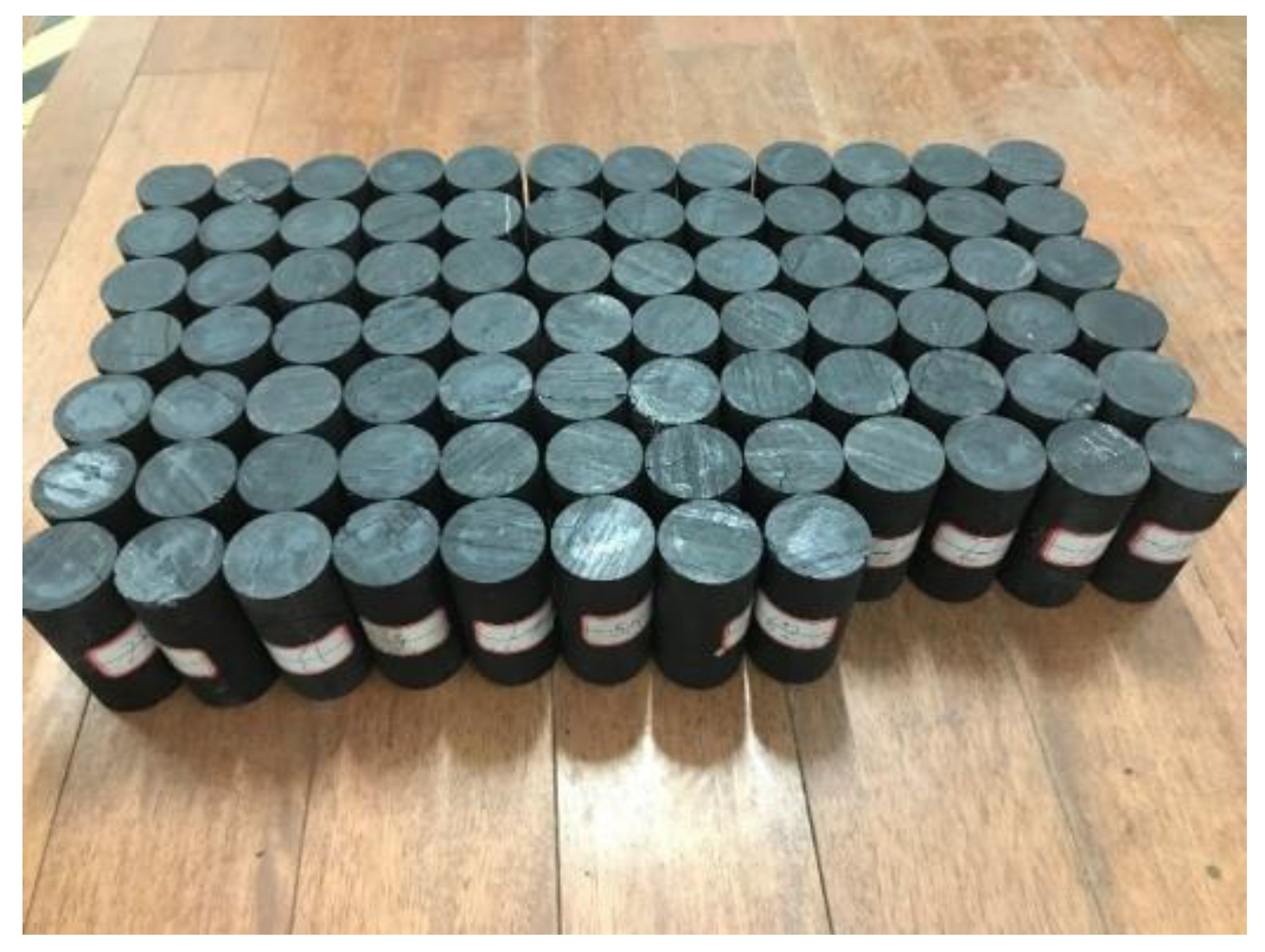
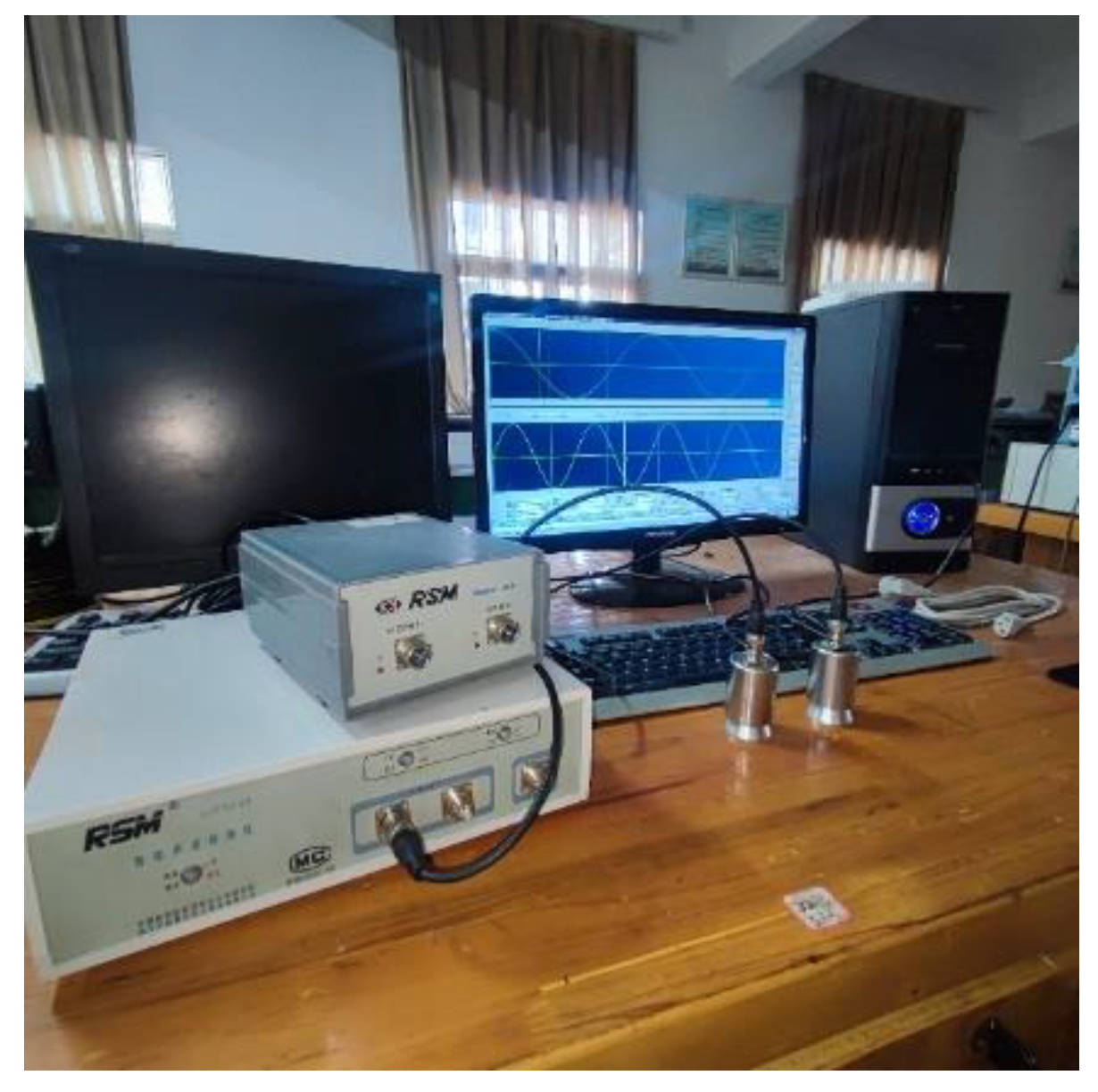
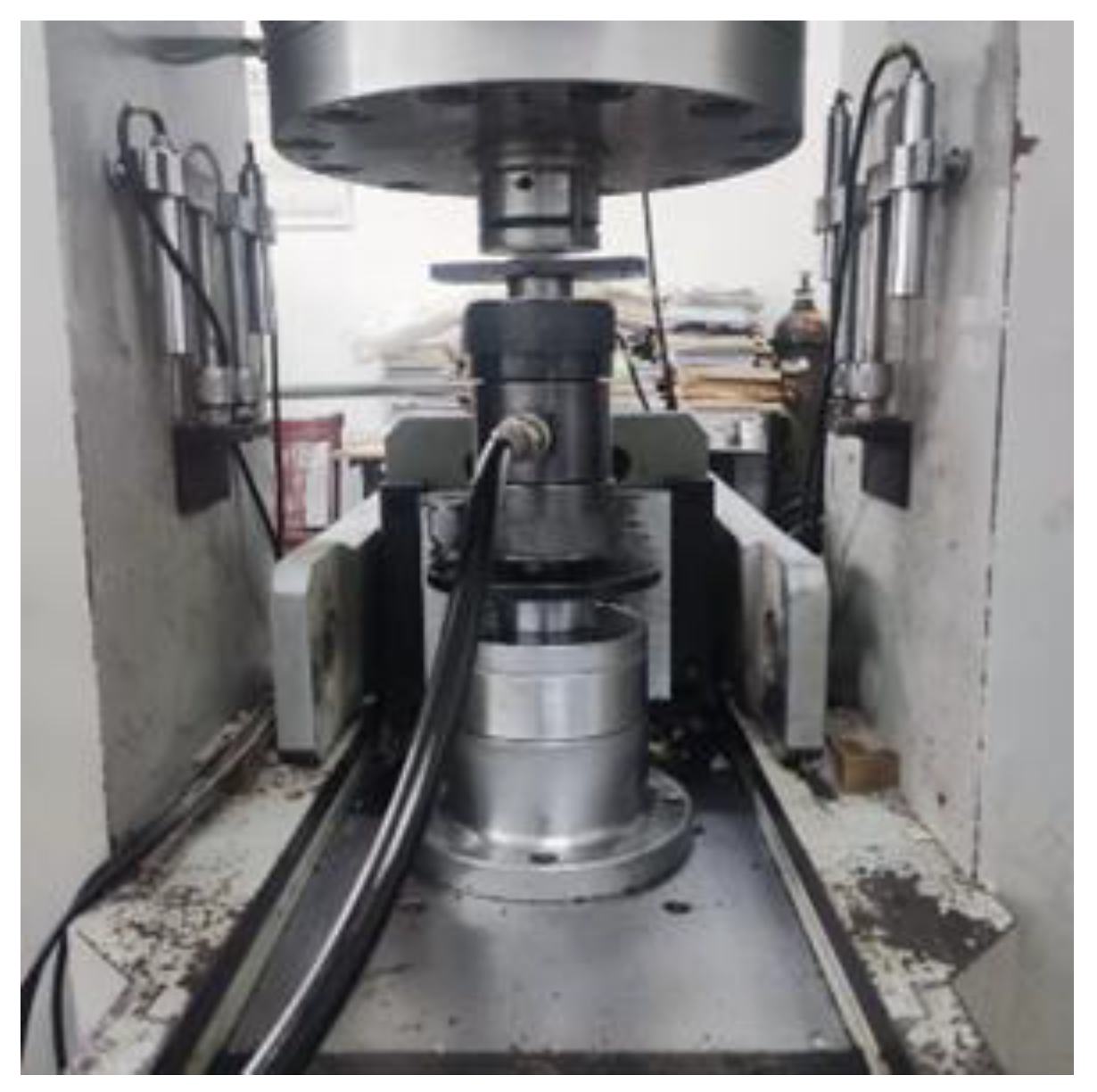
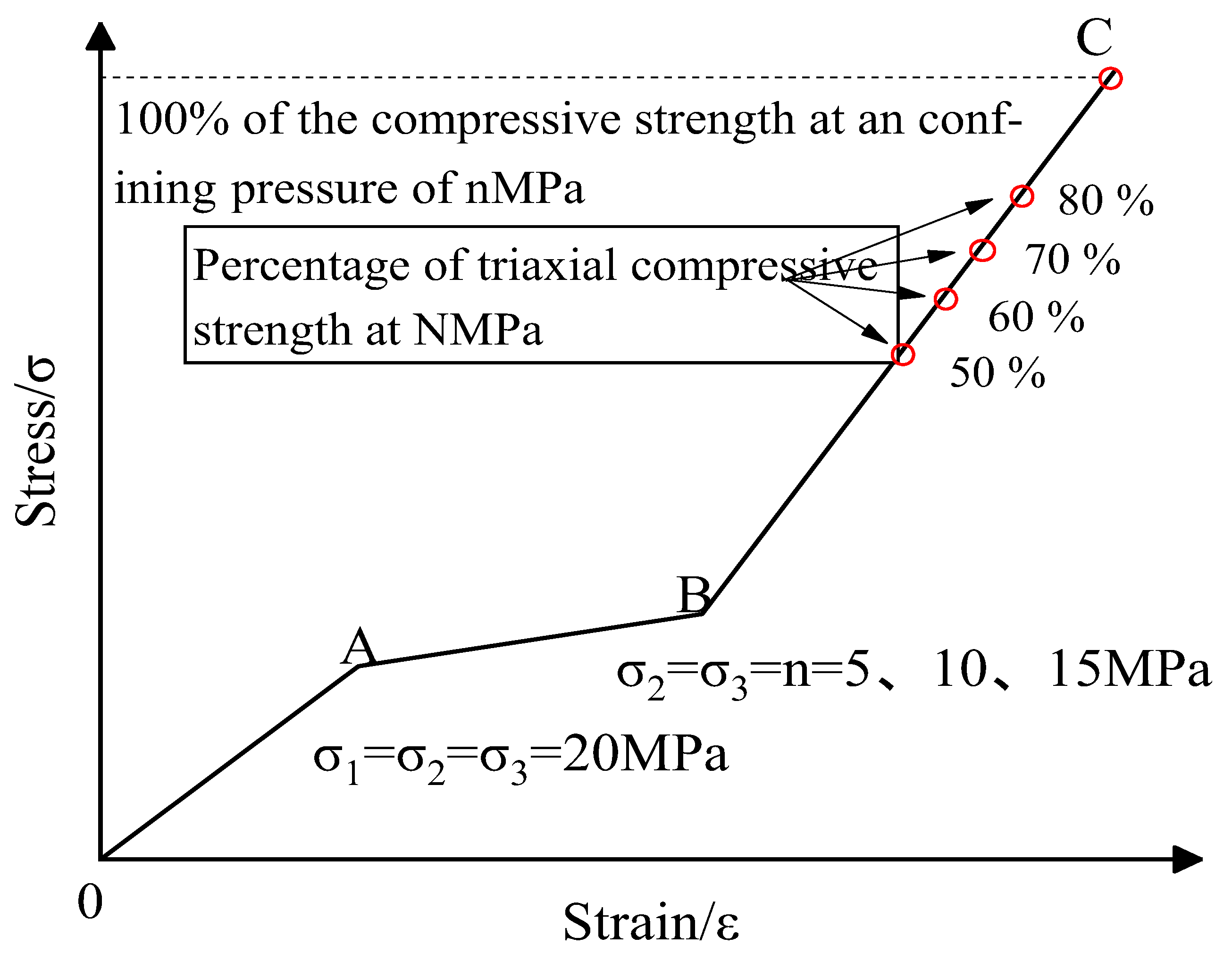

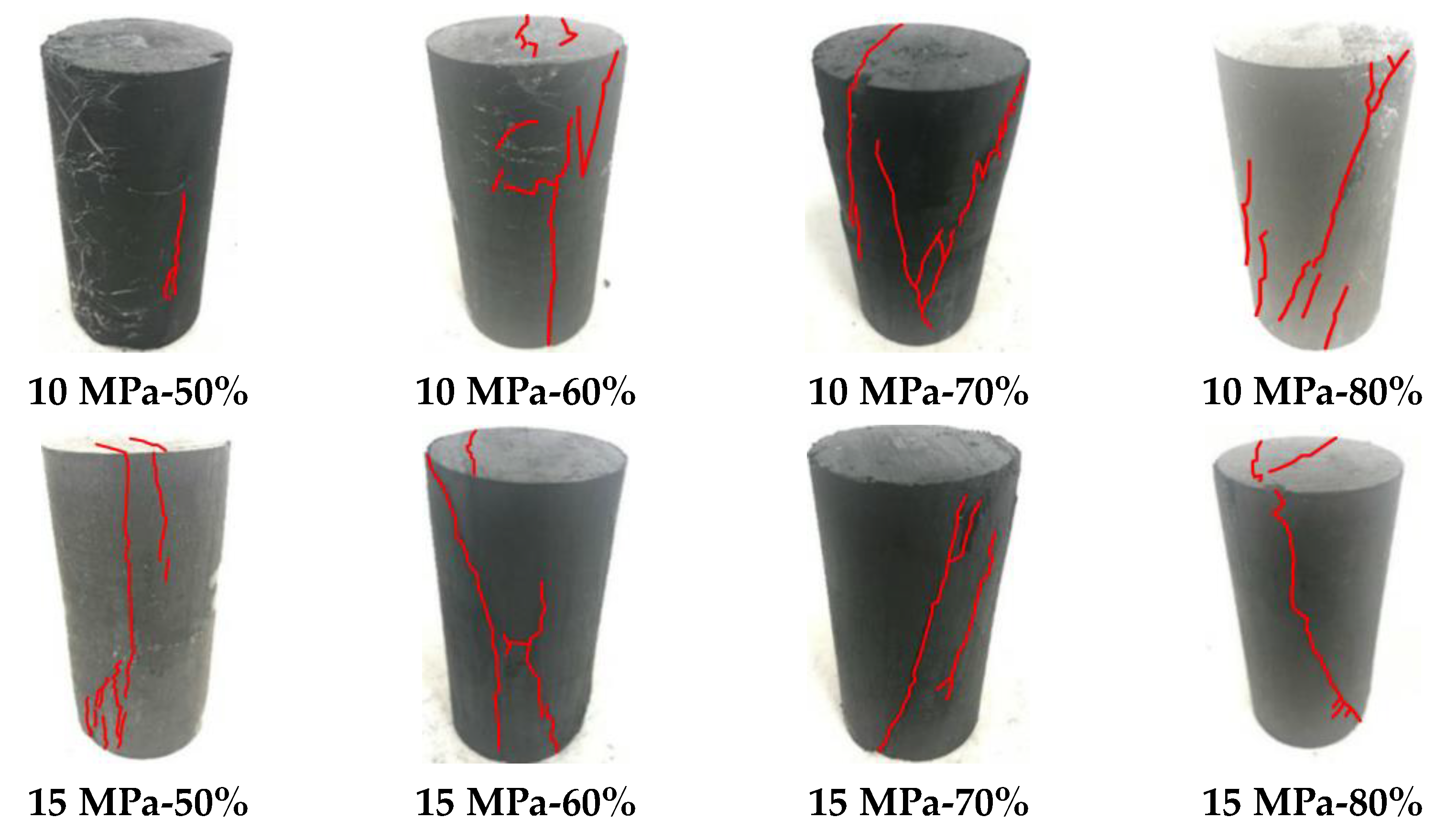
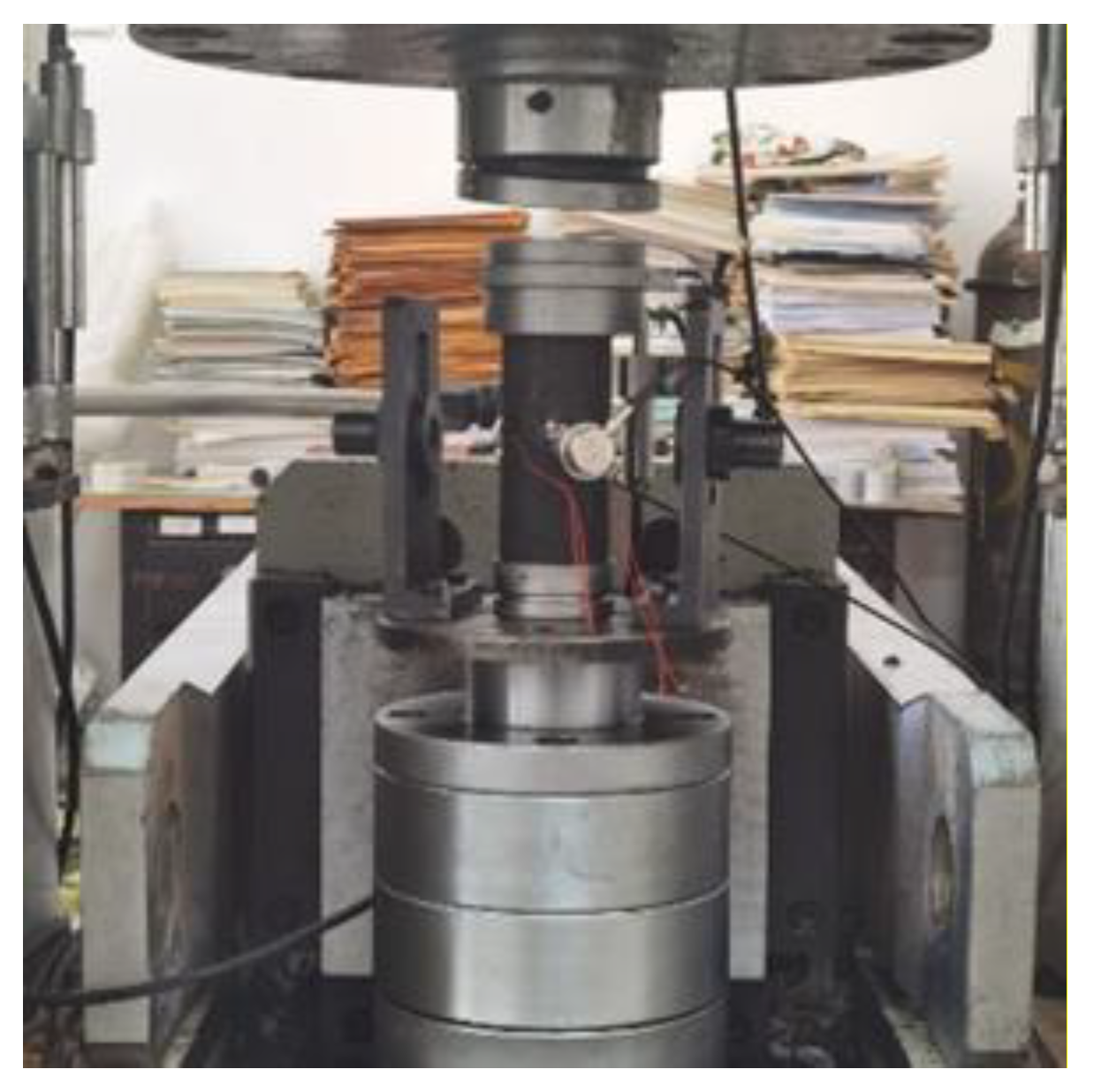
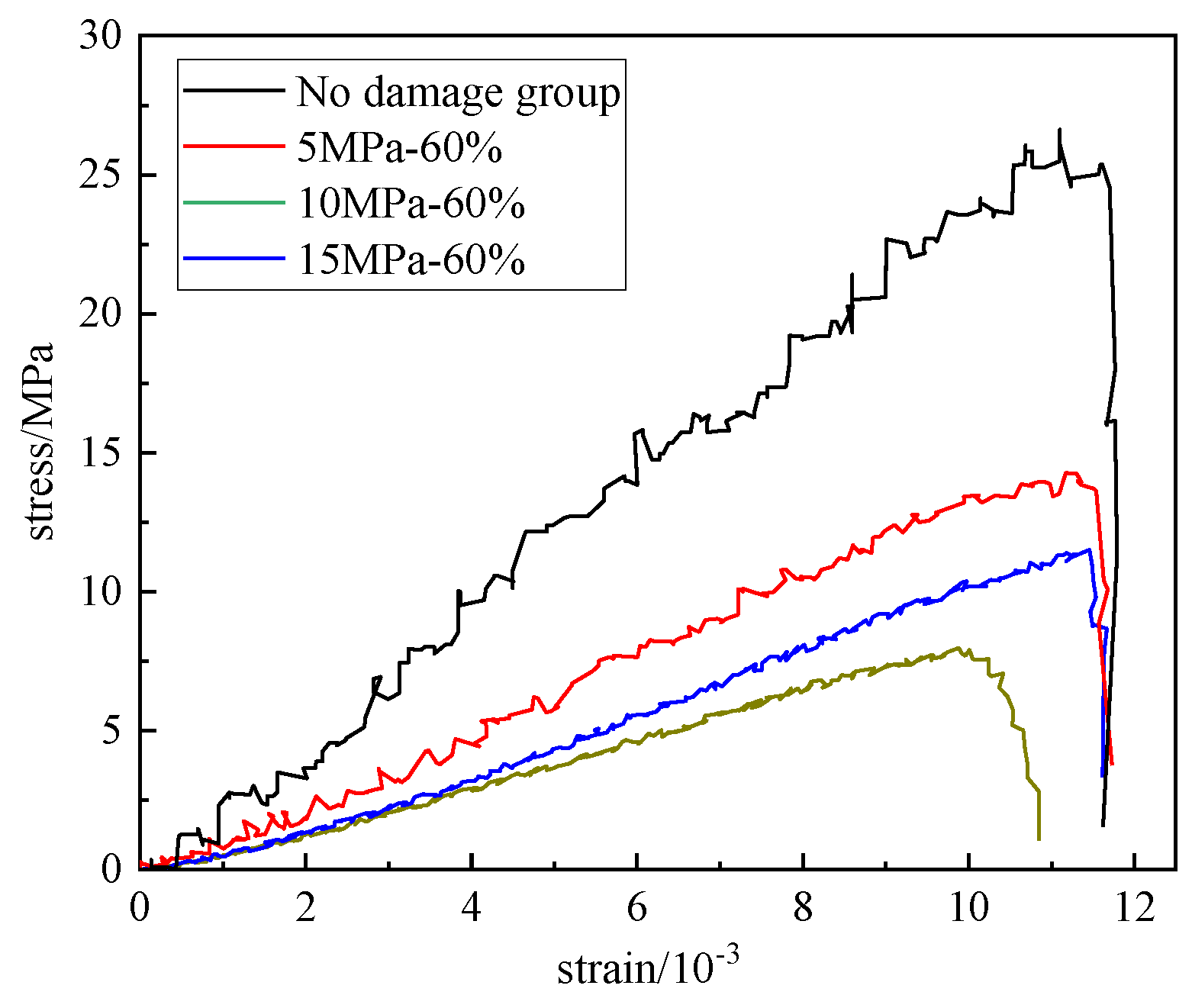


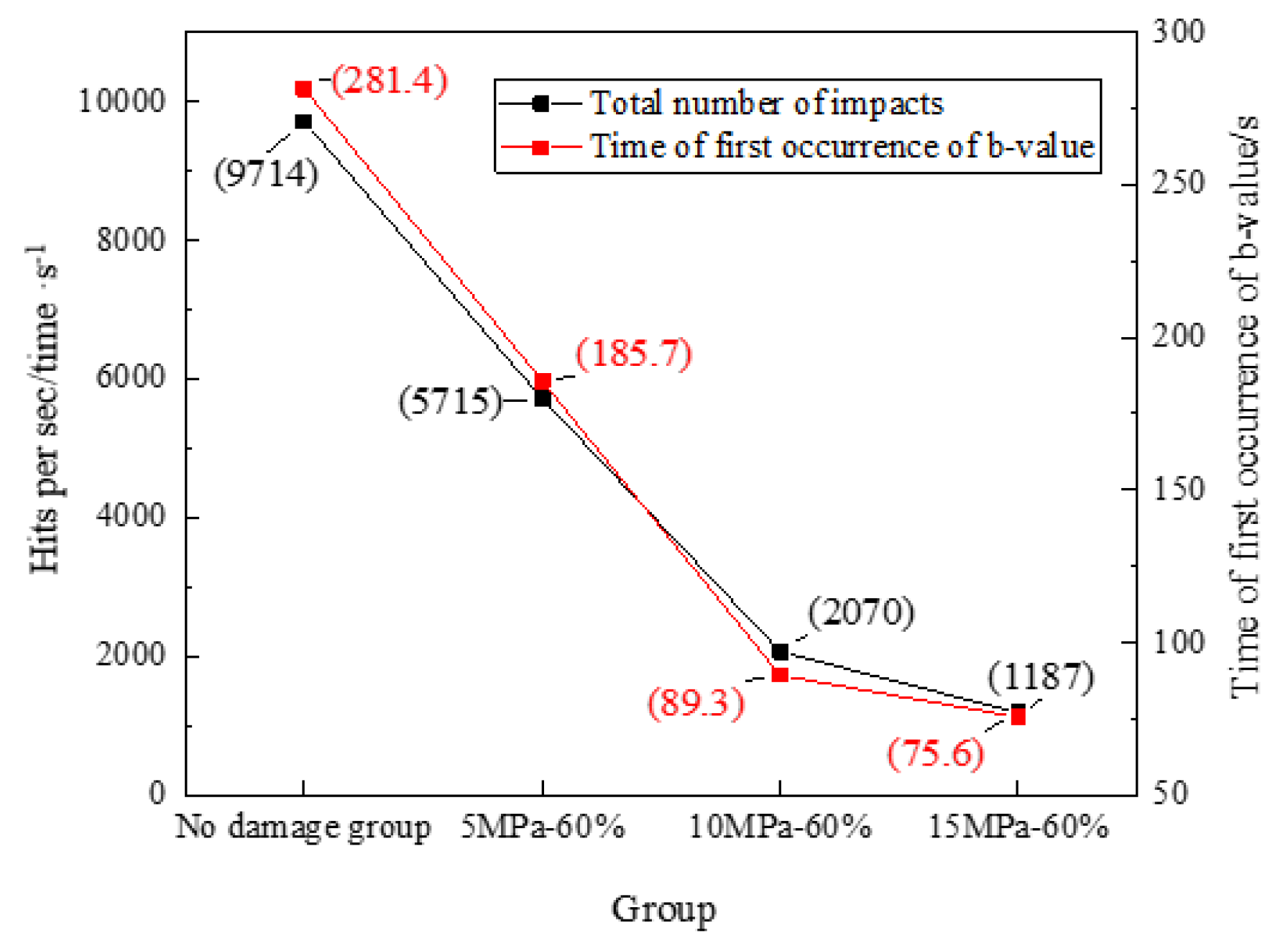
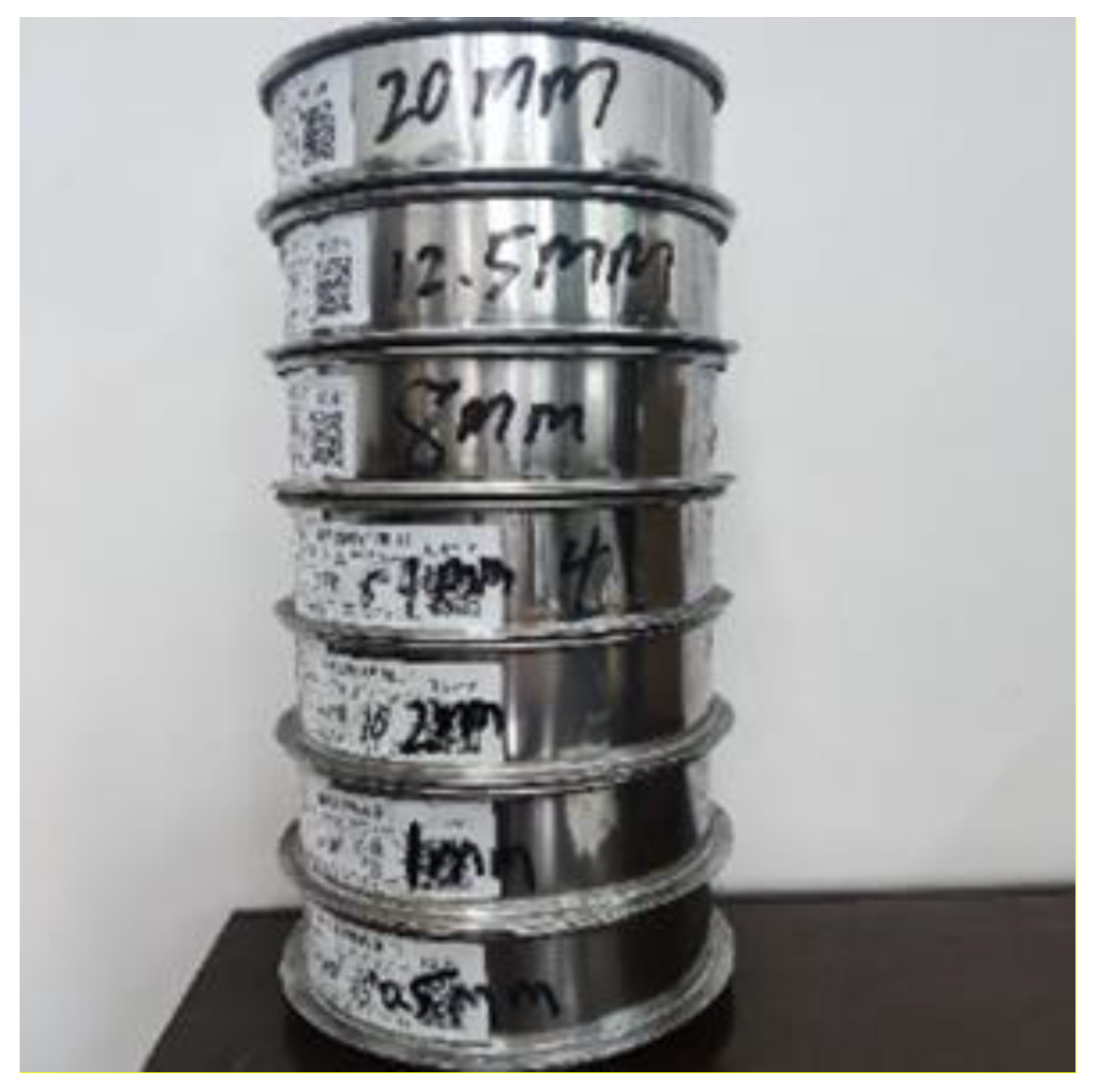
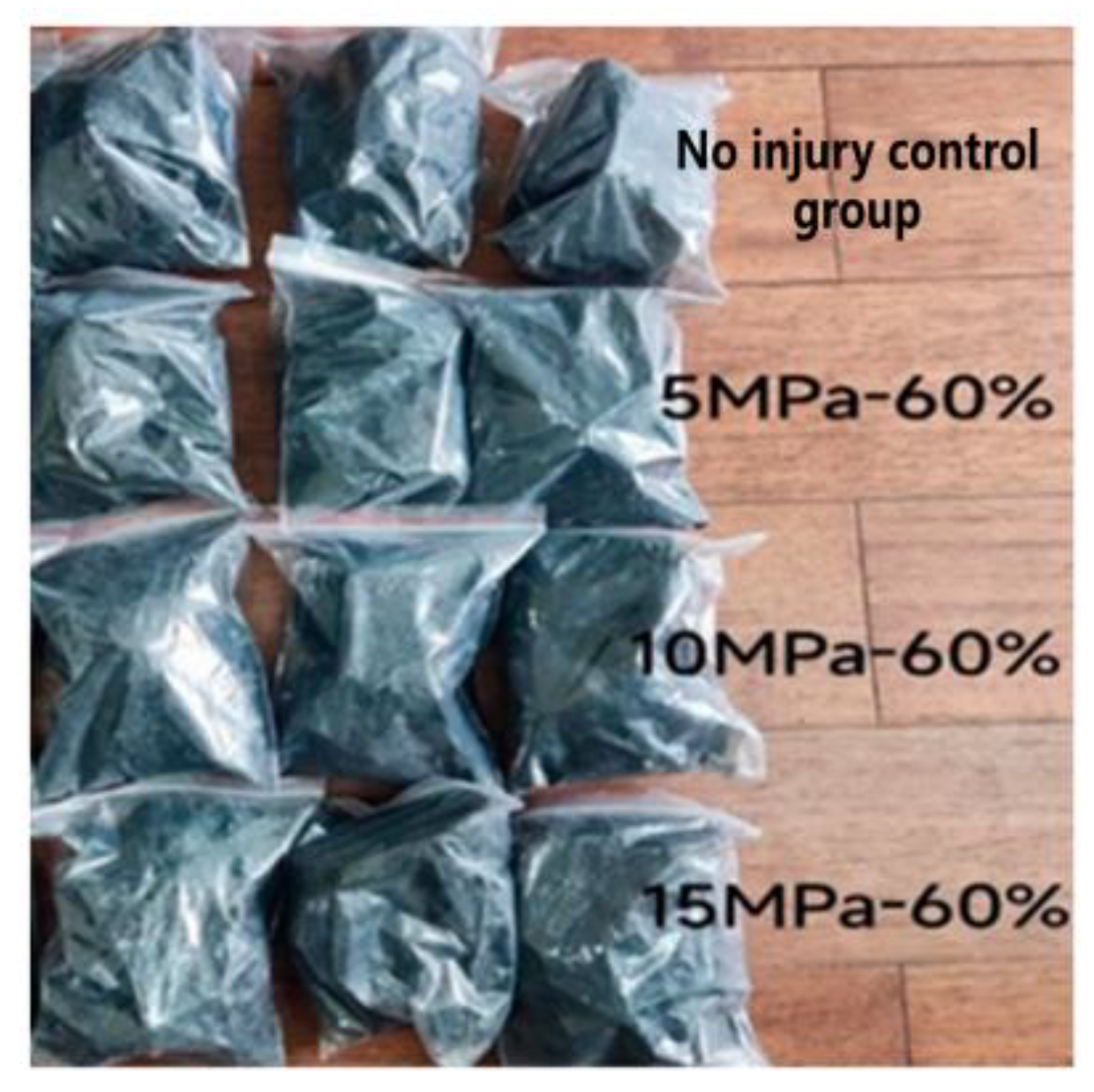
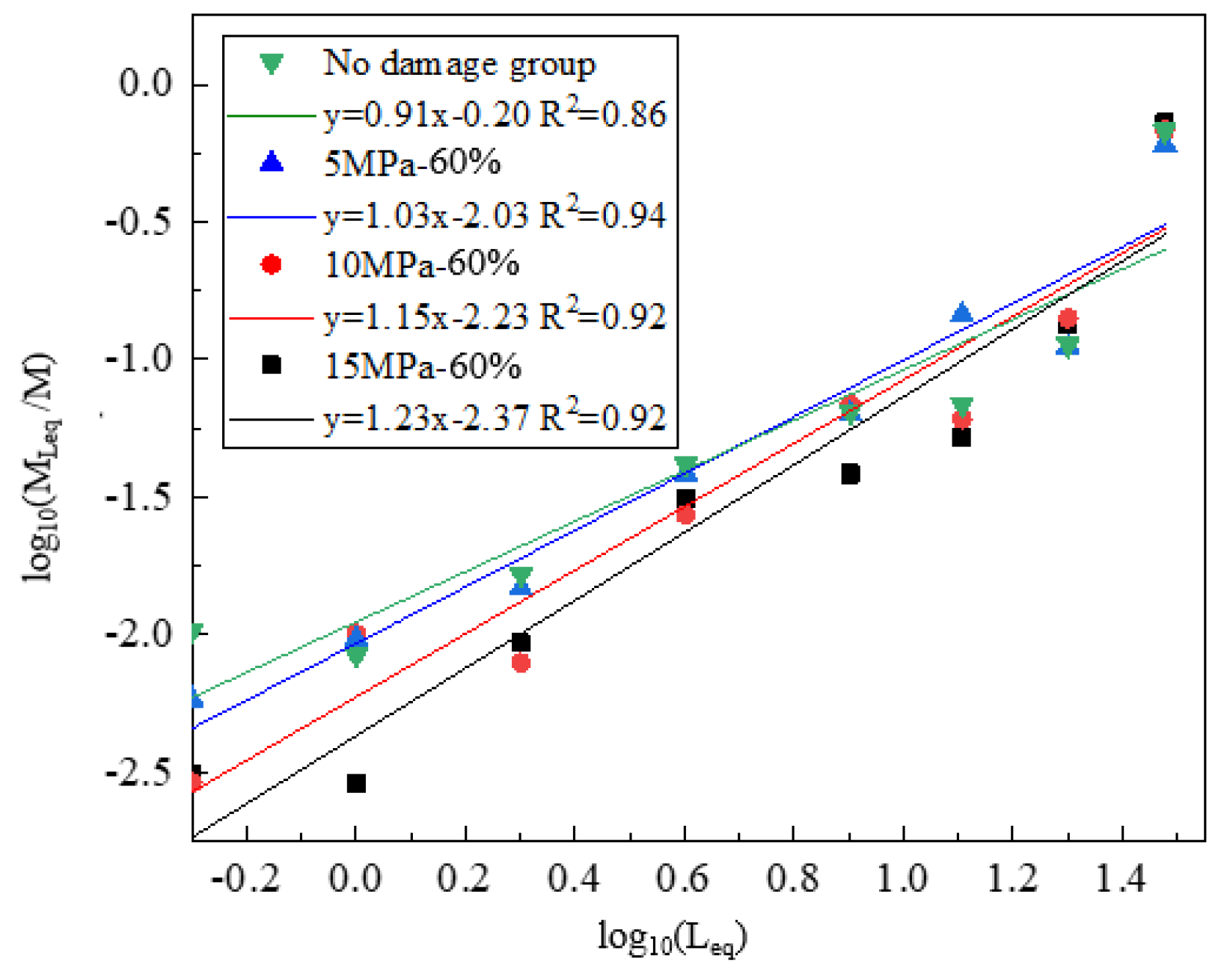
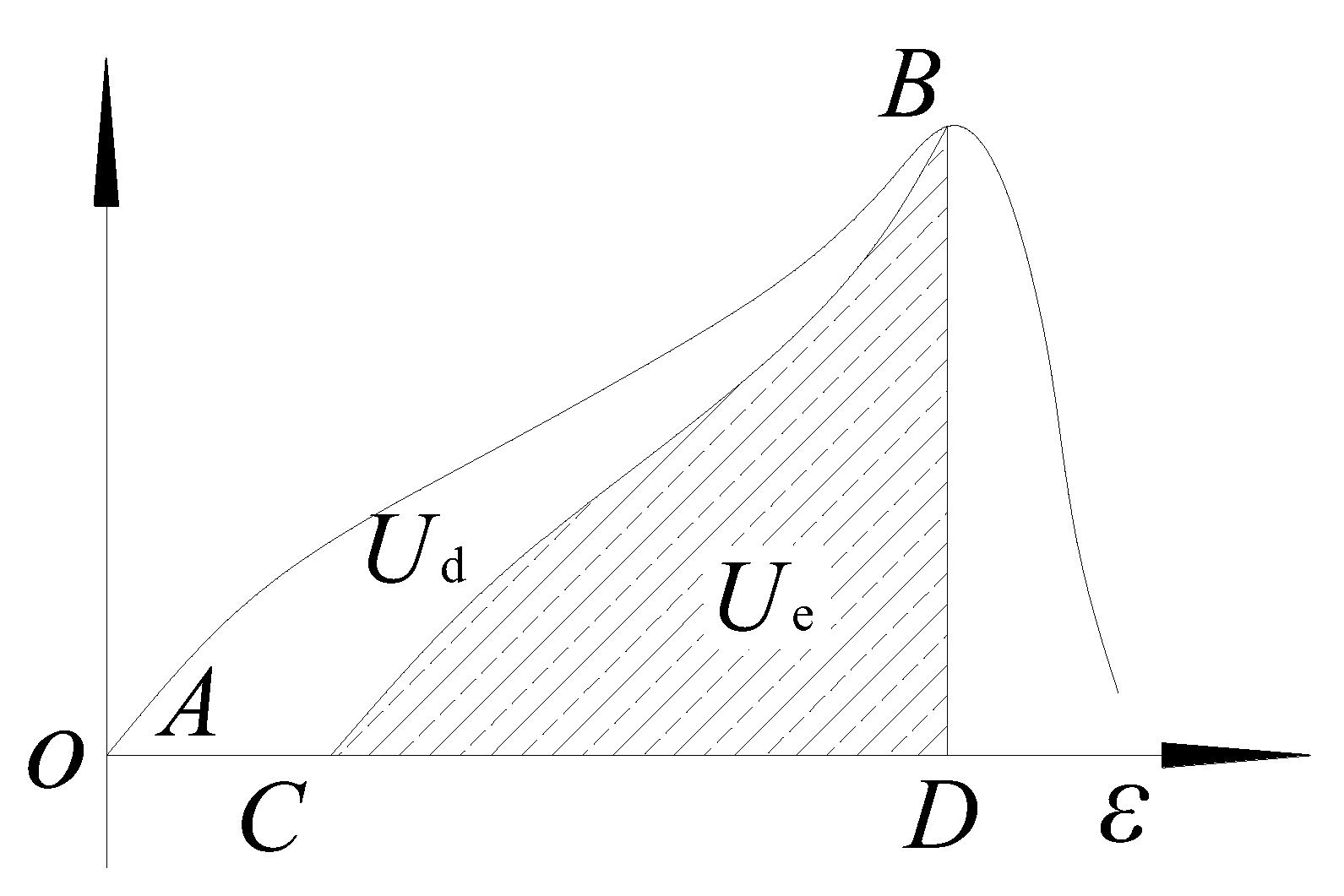
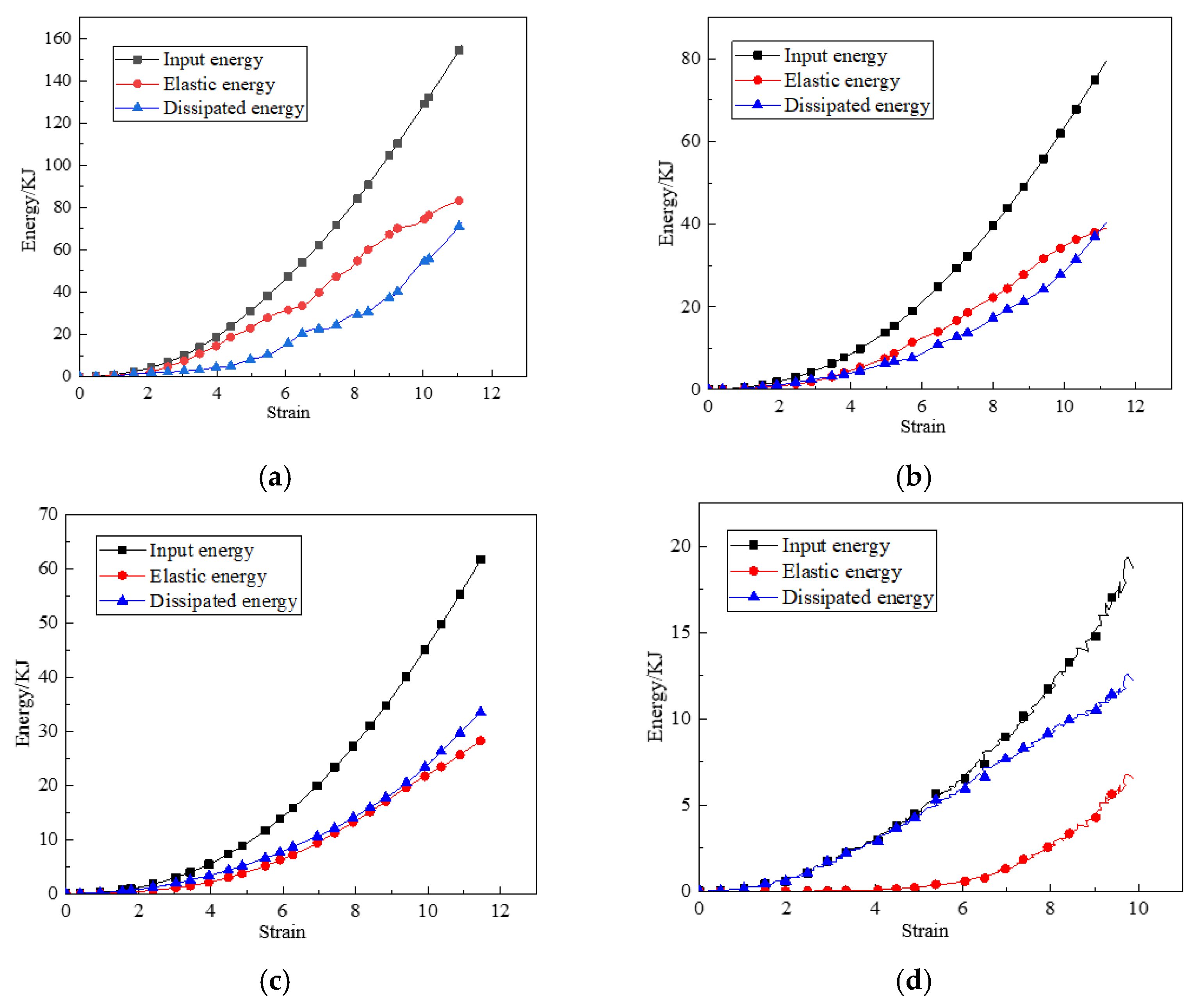
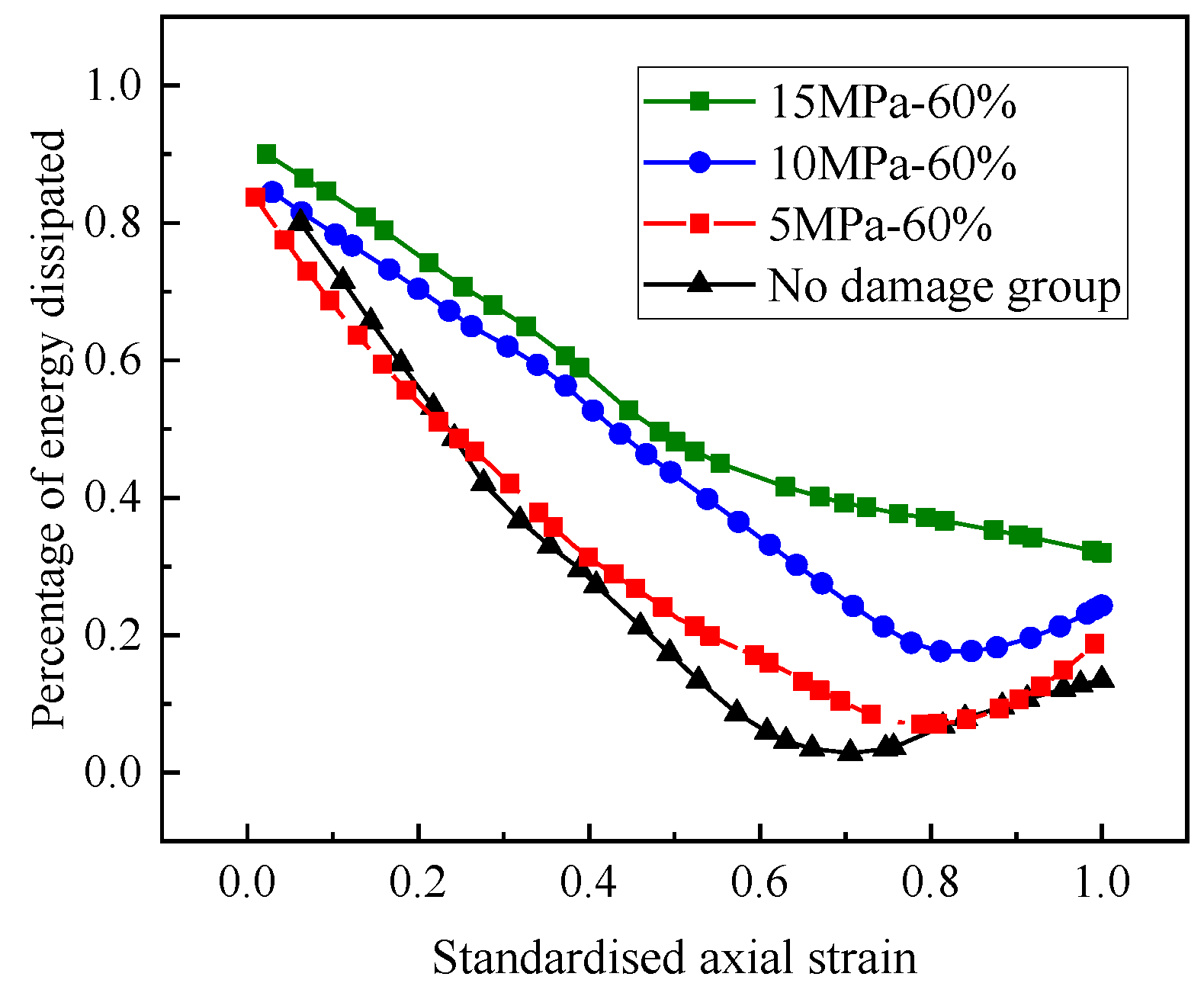
| No. | Wave Speed m/s | No. | Wave Speed m/s | No. | Wave Speed m/s | No. | Wave Speed m/s | No. | Wave Speed m/s |
|---|---|---|---|---|---|---|---|---|---|
| 1 | 1593 | 11 | 1648 | 21 | 1566 | 31 | 1577 | 41 | 1561 |
| 2 | 1509 | 12 | 1553 | 22 | 1543 | 32 | 1629 | 42 | 1652 |
| 3 | 1625 | 13 | 1512 | 23 | 1579 | 33 | 1572 | 43 | 1662 |
| 4 | 1576 | 14 | 1652 | 24 | 1679 | 34 | 1651 | 44 | 1599 |
| 5 | 1576 | 15 | 1513 | 25 | 1501 | 35 | 1601 | 45 | 1647 |
| 6 | 1700 | 16 | 1699 | 26 | 1667 | 36 | 1735 | 46 | 1677 |
| 7 | 1539 | 17 | 1527 | 27 | 1579 | 37 | 1542 | 47 | 1537 |
| 8 | 1639 | 18 | 1639 | 28 | 1529 | 38 | 1542 | 48 | 1560 |
| 9 | 1618 | 19 | 1680 | 29 | 1581 | 39 | 1679 | ||
| 10 | 1730 | 20 | 1585 | 30 | 1684 | 40 | 1550 |
| Surrounding Pressure | 5 MPa | 10 MPa | 15 MPa | |
|---|---|---|---|---|
| Tests Number | ||||
| Tests I/MPa | 50.73 | 62.01 | 79.57 | |
| Tests II/MPa | 47.74 | 60.53 | 74.39 | |
| Tests III/MPa | 44.84 | 67.57 | 74.06 | |
| Average strength/MPa | 47.77 | 63.37 | 76.00 | |
| Group Number | Sieving Diameter/mm | Total Weight/g | Fractal Dimension D | |||||||
|---|---|---|---|---|---|---|---|---|---|---|
| 0.5 | 1 | 2 | 4 | 8 | 12.5 | 20 | 40 | |||
| Control group | 2.55 | 2.07 | 4.06 | 10.22 | 15.83 | 16.8 | 27.82 | 156.59 | 235.94 | 2.08 |
| 5 MPa-60% | 1.36 | 2.25 | 3.46 | 9.01 | 14.86 | 33.94 | 26.02 | 141.18 | 234.08 | 1.97 |
| 10 MPa-60% | 0.79 | 2.44 | 1.91 | 6.58 | 16.64 | 14.7 | 34.23 | 162 | 243.1 | 1.85 |
| 15 MPa-60% | 0.73 | 0.68 | 2.19 | 7.38 | 9.04 | 12.24 | 31.36 | 171.49 | 235.71 | 1.77 |
Disclaimer/Publisher’s Note: The statements, opinions and data contained in all publications are solely those of the individual author(s) and contributor(s) and not of MDPI and/or the editor(s). MDPI and/or the editor(s) disclaim responsibility for any injury to people or property resulting from any ideas, methods, instructions or products referred to in the content. |
© 2023 by the authors. Licensee MDPI, Basel, Switzerland. This article is an open access article distributed under the terms and conditions of the Creative Commons Attribution (CC BY) license (https://creativecommons.org/licenses/by/4.0/).
Share and Cite
Wang, P.; Mei, C.; Zhu, Y. Uniaxial Reloading Damage Characteristics of Critically Damaged Coal Samples at Different Confining Pressure Unloading Spans. Appl. Sci. 2024, 14, 94. https://doi.org/10.3390/app14010094
Wang P, Mei C, Zhu Y. Uniaxial Reloading Damage Characteristics of Critically Damaged Coal Samples at Different Confining Pressure Unloading Spans. Applied Sciences. 2024; 14(1):94. https://doi.org/10.3390/app14010094
Chicago/Turabian StyleWang, Ping, Chengcheng Mei, and Yongjian Zhu. 2024. "Uniaxial Reloading Damage Characteristics of Critically Damaged Coal Samples at Different Confining Pressure Unloading Spans" Applied Sciences 14, no. 1: 94. https://doi.org/10.3390/app14010094
APA StyleWang, P., Mei, C., & Zhu, Y. (2024). Uniaxial Reloading Damage Characteristics of Critically Damaged Coal Samples at Different Confining Pressure Unloading Spans. Applied Sciences, 14(1), 94. https://doi.org/10.3390/app14010094







